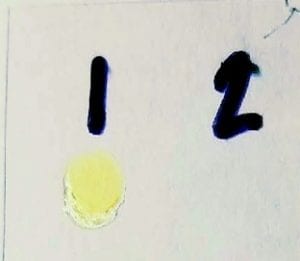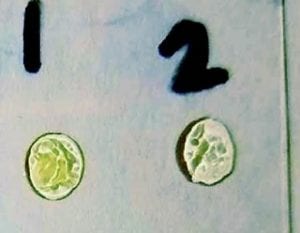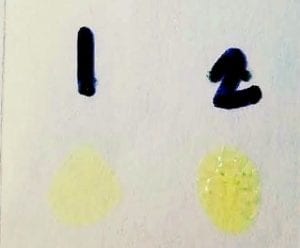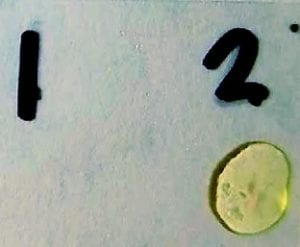The past couple of weeks have been pretty intense inside and outside the lab. Along with my mentor and other NEWT staff we keep working on the development of a suitable photopolymer that will disperse CNTs the best. GREAT NEWS, we have come up with some combinations of monomers that seem to work.
It is like a World Cup of elements. First we started off at the GROUP STAGES by testing how good they react between each other, further added similar concentration of CNTs (0.1%- which was a real challenge due to such small measurement), as shown below.
| Trial No. | Polymer
A |
Polymer
B |
CNTs conc. | Observations |
| 1 | HEMA | PTC | 0.1% | •CNTs don’t disperse properly |
| 2 | HEMA | TET | 0.1% | •Seems to disperse CNTs the best |
| 3 | PEGDA | TET | 0.1% | •CNTs don’t disperse properly |
| 4 | PEGDA | PTC | 0.1% | •CNTs are still attached to walls of container |
| 5 | PEGDA+
ErCl3 |
TET +
SiO2 |
0.1% | •Mixture of all 4 compounds formed a viscous solution.
•ErCl3 (pink crystals) are really hard to disperse |
| 6 | VMS | MMS | 0.1% | •Precipitate formed at the bottom of container when let rest overnight |
From all these 6 combinations, ONLY 3 made it to the next round: PEGDA+ TET, PEGDA+ PTC, and VMS+ MMS. All other 3 were either eliminated because they didn’t disperse CNTs well, or because they didn’t have efficient mechanical properties (e.g HEMA has low boiling point which isn’t good for our 3D Printing technic).
Once on ROUND OF 16, VMS + MMS “se rajo” since CNTs started descending to bottom of container- plus mixture of 2 turned into pale solution after couple of sonication.
Both PEGDA+ PTC (1) and PEGDA +TET (2) made it to the QUARTER FINALS, or Yellow/dark room in this case. There we tested 4 different photo-initiators and exposed to UV-Light to find out which was the most suitable for each monomer. Results are shown below:
Test using 369 ( as observed above formed flat layer of PEGDA + TET)
Hello everyone,
The past couple of weeks have been pretty intense inside and outside the lab. Along with my mentor and other NEWT staff we keep working on the development of a suitable photopolymer that will disperse CNTs the best. GREAT NEWS, we have come up with some combinations of monomers that seem to work.
It is like a World Cup of elements. First we started off at the GROUP STAGES by testing how good they react between each other, further added similar concentration of CNTs (0.1%- which was a real challenge due to such small measurement), as shown below.
| Trial No. | Polymer
A |
Polymer
B |
CNTs conc. | Observations |
| 1 | HEMA | PTC | 0.1% | •CNTs don’t disperse properly |
| 2 | HEMA | TET | 0.1% | •Seems to disperse CNTs the best |
| 3 | PEGDA | TET | 0.1% | •CNTs don’t disperse properly |
| 4 | PEGDA | PTC | 0.1% | •CNTs are still attached to walls of container |
| 5 | PEGDA+
ErCl3 |
TET +
SiO2 |
0.1% | •Mixture of all 4 compounds formed a viscous solution.
•ErCl3 (pink crystals) are really hard to disperse |
| 6 | VMS | MMS | 0.1% | •Precipitate formed at the bottom of container when let rest overnight |
From all these 6 combinations, ONLY 3 made it to the next round: PEGDA+ TET, PEGDA+ PTC, and VMS+ MMS. All other 3 were either eliminated because they didn’t disperse CNTs well, or because they didn’t have efficient mechanical properties (e.g HEMA has low boiling point which isn’t good for our 3D Printing technic).
Once on ROUND OF 16, VMS + MMS “se rajo” since CNTs started descending to bottom of container- plus mixture of 2 turned into pale solution after couple of sonication.
Both PEGDA+ PTC (1) and PEGDA +TET (2) made it to the QUARTER FINALS, or Yellow/dark room in this case. There we tested 4 different photo-initiators (BDR, ACE, TPO, and 369), exposed to UV-Light (for 2-5 minutes), and washed intensely with IPA to find out which was the most suitable for each monomer. Results are shown below (these were previous to adding CNTs):
Test using BDR- each monomer formed thin layers
Test using ACE- PEGDA + PTC formed thin layer, not the same case for PEGDA + TET (didn’t solidify)
Test using TPO- both PEGDA + PTC and PEGDA + TET formed thicker layers, however isn’t flat/even
Test using 369- Flat, fully cured layer of PEGDA + TET was formed, not the same for PEGDA + PTC (didn’t solidify)
From these results we can further conclude that TPO is most suitable photo-initiator to apply to PEGDA + PTC polymer, so is 369 for PEGDA+ TET.
For these week, we are planning on testing now using CNTs (in different concentrations- 0.1% and 0.2%). Thereof I will be gladly keeping you guys update with the latest.
And encourage you guys to come back and check who makes it to the SEMI FINALS, and finally who takes the trophy HOME.
BTW: Thank you everyone for sharing their experiences through here, I really enjoy reading and learning from your experiences.
Hope you guys have an amazing week!
Tahimy



